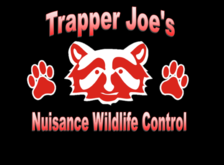
Get matched with top bird and bat pest control pros in your area
Enter your zip and get matched with up to 3 pros
Matching on HomeAdvisor


Bird and bat pest control pros in Lake Saint Louis

Congratulations, you've just found the only animal removal service you'll ever need. At Trapper Joe's Nuisance Wildlife Control, we're so proud of our work we guarantee it! Our commitment is to providing timely, safe and affordable service on every job, big or small, but most of all, we promise results. So whether you have a animal problem or want to make sure you don't get one, we can help. Specializing in nuisance wildlife control, we are a licensed and insured, full service wildlife control company offering the peace of mind that comes with knowing your home is entirely animal-free. We also specialize in attic restoration which includes disinfecting, deodorizing, vacuuming and re-insulating the attic. For more information or to schedule an inspection and price quote, please call us today.
"Very nice and professional."
Jacob N on May 2024
Congratulations, you've just found the only animal removal service you'll ever need. At Trapper Joe's Nuisance Wildlife Control, we're so proud of our work we guarantee it! Our commitment is to providing timely, safe and affordable service on every job, big or small, but most of all, we promise results. So whether you have a animal problem or want to make sure you don't get one, we can help. Specializing in nuisance wildlife control, we are a licensed and insured, full service wildlife control company offering the peace of mind that comes with knowing your home is entirely animal-free. We also specialize in attic restoration which includes disinfecting, deodorizing, vacuuming and re-insulating the attic. For more information or to schedule an inspection and price quote, please call us today.
"Very nice and professional."
Jacob N on May 2024
Bird and bat pest control services FAQs
You're likely to find nesting birds in external areas such as your gutters, eaves, porches, and chimneys. Some birds also nest in less obvious spots, like attics or even in your ventilation systems if they gain access. A reputable pro will conduct an inspection before starting any work to check for evidence of where birds may have set up roosting or nesting sites in your home.
Leaving birds to roost and nest on your home creates significant risks that affect both your home's structure and your well-being. The constant droppings, aggressive swooping, and persistent noise can damage siding, allow moisture intrusion, and stain exterior finishes. In addition, the birds’ pecking and droppings can spread diseases and parasites, which can lead to escalating repair costs and health hazards.
Yes, humane removal is possible and ensures that birds remain unharmed during the extraction process. Experts use proven methods to safely capture and relocate both birds and their nests to secure environments. Professionals employ stainless steel spikes as a deterrent while avoiding harmful techniques such as poisons or glue traps. You can rely on trusted specialists who strictly use safe, noninjurious methods, thereby protecting the birds while resolving the nuisance.
Yes, there are legal considerations when removing birds and their nests. You must adhere to strict local and state regulations, which safeguard protected native species during nesting season. Special authorization is required to remove protected birds, their nests, or eggs under the U.S. Fish and Wildlife Service and the Migratory Bird Treaty Act. Observing these legal mandates avoids violations and ensures safe, responsible removal.
To prevent birds from returning after nest removal, you can implement deterrent methods. Installing stainless steel spikes creates a secure barrier that prevents birds from roosting without causing injury. In contrast, loose nets may entangle birds and other wildlife, creating additional hazards. A trusted professional will choose and install the optimal method to keep your home bird-free.
A bird’s nest remains viable for a period that depends on the species. The construction phase concludes within 2 days to 3 weeks, followed by a rearing stage lasting 2 to 10 weeks. Most birds become fully independent within 2 to 6 weeks, while certain predatory species require up to 2 1/2 months. This timeline can guide you on when it's safe to intervene.





- Birmingham
- Phoenix
- Tucson
- Fresno
- Long Beach
- Los Angeles
- Modesto
- Sacramento
- San Diego
- San Francisco
- San Jose
- Denver
- Hartford
- Washington DC
- Fort Lauderdale
- Jacksonville
- Miami
- Orlando
- Tampa
- Atlanta
- Chicago
- Indianapolis
- Louisville
- New Orleans
- Baltimore
- Boston
- Detroit
- Grand Rapids
- Minneapolis
- Saint Paul
- Kansas City
- Saint Louis
- Las Vegas
- Albany
- New York
- Asheville
- Charlotte
- Greensboro
- Raleigh
- Winston Salem
- Cincinnati
- Cleveland
- Columbus
- Oklahoma City
- Portland
- Harrisburg
- Philadelphia
- Pittsburgh
- Providence
- Memphis
- Nashville
- Austin
- Dallas
- El Paso
- Fort Worth
- Houston
- San Antonio
- Salt Lake City
- Norfolk
- Richmond
- Virginia Beach
- Seattle
- Madison
- Milwaukee



